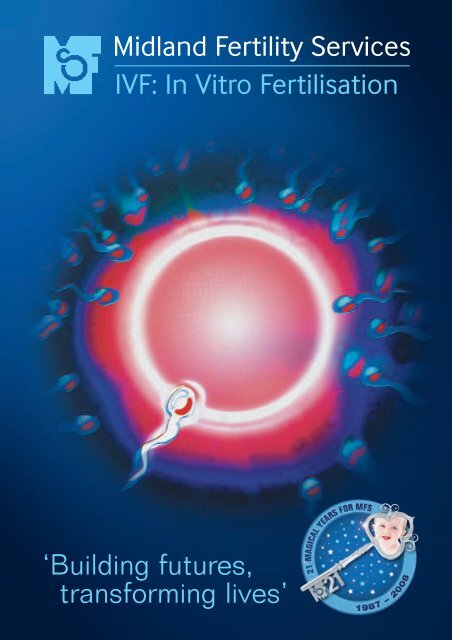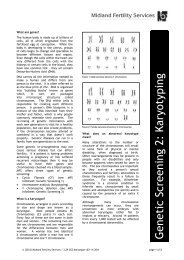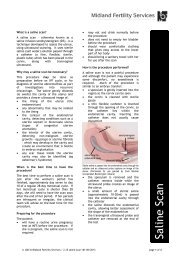download PDF on IVF - Midland Fertility Services
download PDF on IVF - Midland Fertility Services
download PDF on IVF - Midland Fertility Services
You also want an ePaper? Increase the reach of your titles
YUMPU automatically turns print PDFs into web optimized ePapers that Google loves.
<strong>Midland</strong> <strong>Fertility</strong> <strong>Services</strong><br />
<strong>IVF</strong>: In Vitro Fertilisati<strong>on</strong><br />
‘Building futures,<br />
transforming lives’
Useful C<strong>on</strong>tacts<br />
Infertility Network UK 0870 118 8088 www.infertilitynetworkuk.com<br />
British Infertility Counselling Associati<strong>on</strong> (BICA) 01372 451626 www.bica.net<br />
Twins and Multiple Births Associati<strong>on</strong> (TAMBA) 0800 138 0509 www.tamba.org.uk<br />
Miscarriage Associati<strong>on</strong> 01924 200799 www.miscarriageassociati<strong>on</strong>.org.uk
<strong>IVF</strong> Teatment<br />
What is <strong>IVF</strong>?<br />
In vitro fertilisati<strong>on</strong> – <strong>IVF</strong> – literally means<br />
fertilisati<strong>on</strong> ‘in glass’. Instead of the sperm<br />
penetrating the egg (oocyte) within the body<br />
(in vivo), it does so within the laboratory in a<br />
sterile, disposable dish. <strong>IVF</strong> using the standard<br />
inseminati<strong>on</strong> technique requires approximately<br />
150,000 sperm for each egg. The inseminated<br />
eggs are placed in an incubator overnight and<br />
are checked the following morning for signs of<br />
fertilisati<strong>on</strong>. The fertilised eggs (embryos) are<br />
then cultured before placing <strong>on</strong>e or two of the<br />
best quality embryos into the uterus. Any<br />
remaining good quality embryos can be frozen<br />
and stored for any future attempts to c<strong>on</strong>ceive.<br />
How is <strong>IVF</strong> carried out?<br />
In order to give a good chance of pregnancy,<br />
MFS usually collects several eggs by<br />
stimulating the woman’s ovaries using fertility<br />
drugs which start the growth of several<br />
follicles (small fluid filled sacs <strong>on</strong> the ovaries<br />
where the eggs are produced). There are<br />
several ways in which this can be achieved and<br />
your fertility nurse will advise which method<br />
best suits you. The most comm<strong>on</strong> method of<br />
stimulati<strong>on</strong> proceeds as follows.<br />
Preparing your ovaries<br />
The clinical staff will carefully prepare your<br />
ovaries for stimulati<strong>on</strong> and c<strong>on</strong>trol the rate of<br />
growth of the follicles within them. This is best<br />
achieved by first ‘switching off’ the horm<strong>on</strong>es<br />
c<strong>on</strong>trolling your natural menstrual cycle by the<br />
administrati<strong>on</strong> of a drug, given either as an<br />
injecti<strong>on</strong> or via a nasal spray. This drug acts <strong>on</strong><br />
the pituitary gland and may have side effects<br />
similar to the menopause. This is perfectly<br />
normal and is <strong>on</strong>ly temporary.<br />
After two to three weeks of taking this first<br />
drug you will be asked to attend the unit for an<br />
ultrasound scan. MFS will scan your ovaries<br />
and the lining of your uterus to ensure that the<br />
drug has worked sufficiently and that you are<br />
now ‘downregulated’, i.e. your own horm<strong>on</strong>es<br />
have been successfully ‘switched off’. This<br />
scan is therefore often referred to as the<br />
‘down-regulati<strong>on</strong>’ scan.<br />
The next stage is to stimulate your ovaries with<br />
fertility drugs and you will need to inject these<br />
for between seven to 16 days. MFS clinical<br />
staff usually teach you to give your own<br />
injecti<strong>on</strong>s when administering these drugs. If<br />
preferred, your partner can be taught to do this<br />
instead. Most women find that it is not too<br />
difficult to learn and it means that they can<br />
c<strong>on</strong>tinue with their daily routine without too<br />
much interrupti<strong>on</strong>.<br />
You will be asked to attend the unit for some<br />
scans during this period for us to m<strong>on</strong>itor how<br />
many follicles are growing and their sizes.<br />
When we feel that the follicles have grown<br />
<strong>Midland</strong> <strong>Fertility</strong> <strong>Services</strong> | 3
<strong>IVF</strong> Teatment<br />
sufficiently we will inform you of the day of<br />
your egg collecti<strong>on</strong>.<br />
Different drug regimes may be used if this is<br />
thought to be better for you.<br />
Maturing your eggs<br />
Before we can collect the eggs which have<br />
been developing within the follicles we need to<br />
initiate their final stage of development. In<br />
order to mature the eggs you will give yourself<br />
an injecti<strong>on</strong> of hCG. This injecti<strong>on</strong> needs to be<br />
administered at a specific time, 35 hours<br />
before your egg recovery is due. Once the<br />
hCG has been administered, there is no further<br />
need for fertility drugs.<br />
Producing your sperm sample<br />
The sperm sample needs to be produced at the<br />
clinic as so<strong>on</strong> as you arrive and we have a quiet<br />
room close to the laboratories for this purpose.<br />
This means that you can be together both<br />
during your egg recovery and afterwards<br />
whilst you are recovering. In excepti<strong>on</strong>al<br />
circumstances a sperm sample may be<br />
produced at home. If circumstances require,<br />
you may have a sperm sample frozen and<br />
stored prior to this treatment. A charge will be<br />
made for this service.<br />
Egg collecti<strong>on</strong><br />
The procedure is performed under ultrasound<br />
guidance by an experienced practiti<strong>on</strong>er. Each<br />
follicle is punctured in turn and the follicular fluid<br />
drained into sterile tubes via a needle attached<br />
to a sucti<strong>on</strong> pump. The embryologist then<br />
examines the fluid and finds the eggs within it<br />
using a microscope. These eggs are washed and<br />
placed into labelled culture dishes before being<br />
placed into an incubator. The incubator mimics<br />
the inside of the body, keeping the eggs warm<br />
and at low oxygen c<strong>on</strong>centrati<strong>on</strong>s.<br />
4 | <strong>Midland</strong> <strong>Fertility</strong> <strong>Services</strong>
<strong>IVF</strong> Teatment<br />
During the egg recovery you will be given a<br />
local anaesthetic and a sedative; further pain<br />
relief is available if needed. Although you will<br />
be awake during the procedure, most women<br />
describe the procedure <strong>on</strong>ly as uncomfortable<br />
and many hardly recollect it subsequently. A<br />
nurse will be with you c<strong>on</strong>stantly throughout<br />
the procedure, as can your partner, if you<br />
choose. You will be m<strong>on</strong>itored c<strong>on</strong>tinuously to<br />
check your heart rate and oxygen levels. In<br />
very rare cases (about 1 in 100) the drugs may<br />
fail to properly c<strong>on</strong>trol your cycle and you may<br />
ovulate before your egg collecti<strong>on</strong>.<br />
Unfortunately we are unable to predict to<br />
which women this may happen.<br />
Sperm preparati<strong>on</strong><br />
Around the time of the egg collecti<strong>on</strong> a sec<strong>on</strong>d<br />
embryologist prepares the sperm for<br />
inseminati<strong>on</strong>. This is usually from the sample<br />
produced earlier that day, but can also be from<br />
a frozen sample. The best quality sperm are<br />
isolated using a sperm filtrati<strong>on</strong> system and<br />
are then washed in culture media. The sperm<br />
are then placed in the incubator until it is time<br />
for the eggs to be inseminated.<br />
Egg inseminati<strong>on</strong><br />
Later that day approximately 150,000 sperm<br />
are placed with each egg and the dishes are<br />
returned to the incubator overnight. The eggs<br />
are then examined the next morning for signs<br />
of successful fertilisati<strong>on</strong>. Embryos can be<br />
transferred to the uterus between two and six<br />
days after inseminati<strong>on</strong>. Good quality embryos<br />
that are not transferred may be frozen for use<br />
at a later date (refer to the MFS leaflet<br />
entitled ‘Embryo Freezing’).<br />
Oocyte<br />
(EGG)<br />
Fertilised<br />
Oocyte<br />
(2PN)<br />
2 Cell<br />
Embryo<br />
4 Cell<br />
Embryo<br />
8 Cell<br />
Embryo<br />
Sequence of fertilisati<strong>on</strong> and embryo development.<br />
<strong>Midland</strong> <strong>Fertility</strong> <strong>Services</strong> | 5
<strong>IVF</strong> Teatment<br />
How many eggs will fertilise?<br />
The mixing of eggs and sperm ‘in-vitro’ does<br />
not guarantee fertilisati<strong>on</strong>. Successful<br />
fertilisati<strong>on</strong> usually requires a good quality,<br />
mature egg and sperm capable of penetrating<br />
the egg shell (z<strong>on</strong>a). Once a single sperm has<br />
entered, the egg has to prevent any further<br />
sperm from penetrating. A series of<br />
complicated events then take place, involving<br />
the chromosomes (the genetic building blocks)<br />
from both the egg and the sperm.<br />
This delicate procedure is successful for 60-<br />
70% of all eggs inseminated by the<br />
c<strong>on</strong>venti<strong>on</strong>al method. The fertilised eggs are<br />
now referred to as embryos.<br />
The fertilisati<strong>on</strong> rate can vary between<br />
patients and until we have performed your<br />
very first <strong>IVF</strong> cycle we will not know your<br />
pers<strong>on</strong>al fertilisati<strong>on</strong> rate. There is also a<br />
chance that n<strong>on</strong>e of the eggs will fertilise.<br />
When and how are embryos<br />
transferred to the uterus?<br />
Embryos may be transferred to the woman<br />
between two and six days after the egg<br />
recovery and the most suitable day will be<br />
discussed with you when planning your<br />
treatment (see also the MFS leaflet entitled<br />
‘Blastocyst Transfer’). The embryo transfer<br />
procedure is ordinarily very straightforward<br />
and takes approximately twenty minutes to<br />
perform; no l<strong>on</strong>ger than an average cervical<br />
smear.<br />
The procedure is performed by a highly trained<br />
nurse or doctor. Sedati<strong>on</strong> or pain relief is not<br />
normally necessary. The nurse or doctor and<br />
embryologist performing the embryo transfer<br />
will discuss the quality of your embryos with<br />
you before the procedure.<br />
The embryos are then loaded into a catheter (a<br />
fine sterile, plastic tube) which the nurse or<br />
doctor threads carefully through the cervix (the<br />
neck of the womb) and into the uterus under<br />
ultrasound guidance. When it is in the perfect<br />
positi<strong>on</strong>, the embryos are expelled from the tip<br />
of the catheter. The catheter is passed back to<br />
the embryologist who checks that they have<br />
been successfully transferred and that they<br />
have not been retained within the catheter. You<br />
will be given some horm<strong>on</strong>es, usually in the form<br />
of vaginal pessaries, which you will be asked to<br />
administer in the days following your embryo<br />
transfer. These horm<strong>on</strong>es help to maintain a<br />
thick endometrial lining, providing the optimal<br />
envir<strong>on</strong>ment for the embryos to implant.<br />
6 | <strong>Midland</strong> <strong>Fertility</strong> <strong>Services</strong>
Do I need to take any precauti<strong>on</strong>s<br />
following my embryo transfer?<br />
<strong>IVF</strong> Teatment<br />
Providing you feel well, you should be able to<br />
c<strong>on</strong>tinue with your everyday tasks as normal.<br />
Some people wish to c<strong>on</strong>tinue working in order<br />
to take their mind off the two week wait for<br />
their pregnancy test. Others prefer to take<br />
things easier. Your doctor or nurse will give you<br />
some advice <strong>on</strong> these matters following your<br />
embryo transfer.<br />
What happens to any<br />
remaining embryos?<br />
Good quality embryos that are not transferred<br />
may be frozen for use at a later date (refer to<br />
the MFS leaflet entitled ‘Embryo Freezing’).<br />
You may be asked to c<strong>on</strong>tact the embryologists<br />
to find out if we have been able to freeze any<br />
embryos and you will also receive a written<br />
summary of the treatment cycle, which will<br />
include this informati<strong>on</strong>. Only suitable embryos<br />
will be frozen as they have to meet strict<br />
criteria if they are to survive the procedure.<br />
For whom is <strong>IVF</strong> suitable?<br />
There are several types of sub-fertility where<br />
<strong>IVF</strong> can help, such as tubal blockage,<br />
endometriosis, male infertility and unexplained<br />
infertility. Some couples who have tried less<br />
invasive fertility treatments, such as intra<br />
uterine inseminati<strong>on</strong> (IUI) may wish to try <strong>IVF</strong><br />
if these other procedures have failed. <strong>IVF</strong> can<br />
give the fertility team more informati<strong>on</strong><br />
regarding the quality of the eggs and whether<br />
fertilisati<strong>on</strong> is taking place. Also, women<br />
whose Fallopian tubes are blocked, so<br />
preventing the sperm from reaching the egg, or<br />
the embryo from reaching the uterus, will<br />
require this blockage to be either removed by<br />
surgery or by-passed using <strong>IVF</strong>. Your fertility<br />
nurse specialist will discuss the advantages,<br />
disadvantages and limitati<strong>on</strong>s of <strong>IVF</strong> with you<br />
to help you decide if this is the treatment most<br />
suited to your own particular situati<strong>on</strong>.<br />
<strong>Midland</strong> <strong>Fertility</strong> <strong>Services</strong> | 7
<strong>IVF</strong> Teatment<br />
How safe is <strong>IVF</strong>?<br />
The procedures which are performed for <strong>IVF</strong>,<br />
such as the egg recovery and embryo<br />
transfer, are all out-patient procedures which<br />
do not require a general anaesthetic, <strong>on</strong>ly<br />
sedati<strong>on</strong>. They are classed as relatively low<br />
risk and thousands of women each year<br />
undergo <strong>IVF</strong> with no problems whatsoever.<br />
There are, however, three main areas that<br />
can cause problems.<br />
OHSS<br />
Ovarian Hyperstimulati<strong>on</strong> Syndrome (OHSS) is<br />
caused by an over-resp<strong>on</strong>se by the ovaries to the<br />
fertility drugs. MFS aims to develop<br />
approximately eight – 10 follicles but sometimes<br />
many more can grow. This syndrome can have<br />
symptoms, which range from very minor, such as<br />
feeling slightly bloated, to quite serious side<br />
effects, which may require hospitalisati<strong>on</strong>. Some<br />
people are more pr<strong>on</strong>e to this occurring than<br />
others. MFS will try to predict how well your<br />
ovaries will resp<strong>on</strong>d to the drugs by measuring<br />
various horm<strong>on</strong>e levels before you start your<br />
treatment – thereby helping us to prescribe an<br />
appropriate level of fertility drug. You will be<br />
given ultrasound scans throughout your ovarian<br />
stimulati<strong>on</strong> so that the rate of follicular<br />
development can be m<strong>on</strong>itored and your dose of<br />
drug will be adjusted if we think your ovaries are<br />
over-resp<strong>on</strong>ding. Your nurse will inform you of the<br />
signs of OHSS to look out for but you should also<br />
read the leaflet entitled ‘OHSS’. The symptoms<br />
of OHSS can become far worse in pregnancy and<br />
so <strong>on</strong> rare occasi<strong>on</strong>s we may wish to freeze all of<br />
the embryos and delay your embryo transfer until<br />
we feel that it is safe to do so.<br />
Multiple Pregnancy<br />
Approximately 25% of all <strong>IVF</strong> pregnancies at<br />
MFS are multiple, mainly twins (24%) and, much<br />
less comm<strong>on</strong>ly, triplets (1%). Although the<br />
thought of an instant family can be quite<br />
appealing, especially after the efforts of fertility<br />
treatment, multiple pregnancies bring additi<strong>on</strong>al<br />
risks both to mother and babies. The HFEA now<br />
limits the number of embryos that may be<br />
transfered to a maximum of two for women<br />
under 40 years old. The HFEA has also<br />
recommended reducing the multiple birth rate to<br />
10% and so, for certain patients a single embryo<br />
transfer may be advised. A multiple pregnancy<br />
carries an increased risk of the babies suffering<br />
l<strong>on</strong>g-term disabilities or handicaps such as<br />
cerebral palsy and they are also much more<br />
likely to suffer from chr<strong>on</strong>ic health problems<br />
associated with low birth weight. The extra<br />
strain <strong>on</strong> physical, emoti<strong>on</strong>al and financial<br />
resources when caring for more than <strong>on</strong>e baby<br />
at a time cannot be ignored. (Please refer to the<br />
MFS leaflet ‘Multiple Pregnancies.)<br />
Ectopic Pregnancy<br />
There is also a risk that a pregnancy can develop<br />
in the Fallopian tubes instead of the uterus. This<br />
is known as an ectopic pregnancy which, if left<br />
undetected, can have serious c<strong>on</strong>sequences.<br />
Following a positive pregnancy test, you will be<br />
asked to return to the unit two weeks later for<br />
an early pregnancy scan. At this scan, we will<br />
check that the pregnancy is a healthy <strong>on</strong>e and<br />
that it is inside the uterus. (Please refer to the<br />
MFS leaflet entitled ‘Ectopic Pregnancy’.)<br />
8 | <strong>Midland</strong> <strong>Fertility</strong> <strong>Services</strong>
<strong>IVF</strong> Teatment<br />
The impact of treatment <strong>on</strong><br />
<strong>IVF</strong>-c<strong>on</strong>ceived babies<br />
The evidence so far is that pregnancies<br />
following <strong>IVF</strong> treatment proceed in the same<br />
way as other pregnancies, but fertility patients<br />
may face other anxieties. Over three milli<strong>on</strong><br />
babies have been born world-wide following<br />
<strong>IVF</strong> treatment and, to date, c<strong>on</strong>tinuing<br />
research into l<strong>on</strong>g term effects has identified<br />
no significant problems.<br />
Do I need to give permissi<strong>on</strong> for <strong>IVF</strong>?<br />
Once you have decided that <strong>IVF</strong> is an<br />
appropriate treatment, you will be asked<br />
to complete various forms, including giving<br />
c<strong>on</strong>sent to the egg recovery, the mixing of your<br />
eggs and sperm and the embryo transfer.<br />
How successful is <strong>IVF</strong> with MFS?<br />
<strong>Midland</strong> <strong>Fertility</strong> <strong>Services</strong> started <strong>IVF</strong> in 1987<br />
and the pregnancy rates have improved<br />
significantly over the years and are well above<br />
the nati<strong>on</strong>al average. However, like all types of<br />
<strong>IVF</strong> everywhere, a single cycle is still more<br />
likely to fail than succeed. Please visit<br />
www.midlandfertility.com for the success<br />
rates for <strong>IVF</strong> at MFS or see our current<br />
Patients’ Guide to <strong>Services</strong>. If you have not<br />
received a copy of this, or would like some<br />
help in understanding the data, please ask a<br />
member of staff.<br />
<strong>Midland</strong> <strong>Fertility</strong> <strong>Services</strong> | 9
<strong>IVF</strong> Teatment<br />
What happens if treatment fails?<br />
If your treatment fails we may still be able to<br />
learn something from it and we will certainly<br />
share our experiences with you. As with all<br />
forms of fertility treatment, the process can<br />
be physically, financially and emoti<strong>on</strong>ally<br />
draining. Staff at MFS are here to support<br />
you, including our team of counsellors (see<br />
the MFS leaflet entitled ‘Counselling’).<br />
When you feel ready, we are here to talk<br />
about your treatment and to give advice <strong>on</strong><br />
any future treatment opti<strong>on</strong>s you may want<br />
to c<strong>on</strong>sider.<br />
If you have decided that you no l<strong>on</strong>ger want to<br />
pursue fertility treatment, you may wish to<br />
explore other ways of achieving a family.<br />
Disc<strong>on</strong>tinuing fertility treatment can be a<br />
difficult decisi<strong>on</strong>, and you may wish to talk<br />
these issues through with a counsellor.<br />
Please ask any of the MFS team if you require<br />
teleph<strong>on</strong>e numbers for MFS counselling<br />
services, other support groups or adopti<strong>on</strong><br />
agencies, or visit www.midlandfertility.com and<br />
view the ‘Useful Links’ page.<br />
What happens if pregnancy occurs?<br />
Please c<strong>on</strong>tact MFS as so<strong>on</strong> as you know the<br />
result of your treatment, whatever the outcome.<br />
Not <strong>on</strong>ly will our staff be delighted to know that<br />
the treatment has been successful, but equally<br />
important, we have a legal duty to inform the<br />
HFEA of the outcome. You may have been given<br />
some horm<strong>on</strong>es to help maintain a healthy<br />
endometrium in which the embryo can implant,<br />
in the form of injecti<strong>on</strong>s, tablets or vaginal<br />
pessaries. If you have a positive pregnancy test<br />
you may have to request a further supply. Do<br />
not stop taking these until you have checked<br />
with your fertility nurse or MFS doctor.<br />
Following a positive pregnancy test you can<br />
book an appointment for a pregnancy scan two<br />
weeks later. At this very early stage of<br />
development, we should be able to see a<br />
gestati<strong>on</strong>al sac c<strong>on</strong>taining the developing fetus<br />
with a beating heart. This scan is important to<br />
ensure that the pregnancy is developing<br />
normally, within the uterus.<br />
Once this early scan has been performed, you<br />
can visit your GP and be booked for your<br />
antenatal care like any other pregnancy. Of<br />
course, you are welcome to c<strong>on</strong>tact <strong>Midland</strong><br />
<strong>Fertility</strong> <strong>Services</strong> at any time for advice or just<br />
to let us know how you are getting <strong>on</strong>. We shall<br />
obviously be looking forward to the news <strong>on</strong> the<br />
delivery, and again have a legal duty to report<br />
the outcome of your pregnancy to the HFEA.<br />
10 | <strong>Midland</strong> <strong>Fertility</strong> <strong>Services</strong>
<strong>IVF</strong> Teatment<br />
Next steps<br />
If you are interested in <strong>IVF</strong> and feel that it<br />
might be an appropriate treatment for you, talk<br />
it over with your fertility nurse specialist. She<br />
will be able to discuss the issues involved in<br />
greater detail and will also be able to give<br />
you the latest results from MFS. Scientific<br />
staff are always available to give informati<strong>on</strong><br />
and guidance.<br />
<strong>Midland</strong> <strong>Fertility</strong> <strong>Services</strong> | 11
List of <strong>Services</strong><br />
●<br />
●<br />
●<br />
●<br />
●<br />
●<br />
●<br />
●<br />
●<br />
●<br />
In Vitro Fertilisati<strong>on</strong> (<strong>IVF</strong>)<br />
Intra Cytoplasmic Sperm Injecti<strong>on</strong> (ICSI)<br />
Surgical Sperm Recovery<br />
(PESA/TESA)<br />
Embryo Freezing<br />
Blastocyst Culture<br />
Intra Uterine Inseminati<strong>on</strong> (IUI)<br />
Sperm Storage<br />
Assisted Hatching<br />
Egg Freezing<br />
Egg D<strong>on</strong>ati<strong>on</strong><br />
●<br />
●<br />
●<br />
●<br />
●<br />
●<br />
●<br />
●<br />
●<br />
Egg Sharing<br />
Tubal Patency Testing<br />
<strong>Fertility</strong> Investigati<strong>on</strong> Package<br />
Phospholipid Auto-antibody Screen<br />
Sperm Analysis<br />
Recurrent Pregnancy Loss and<br />
Implantati<strong>on</strong> Failure<br />
Genetic Screening<br />
Ovarian Reserve Testing<br />
Vasectomy Reversal Back-Up<br />
How to get to <strong>Midland</strong> <strong>Fertility</strong> <strong>Services</strong><br />
Third Floor, Centre House,<br />
Court Parade, Aldridge,<br />
West <strong>Midland</strong>s WS9 8LT<br />
t: 01922 455911<br />
f: 01922 459020<br />
e: mfs@midlandfertility.com<br />
w: www.midlandfertility.com<br />
Issue: 3-06/2008






